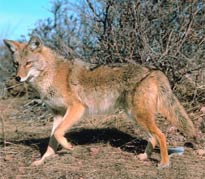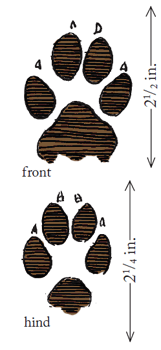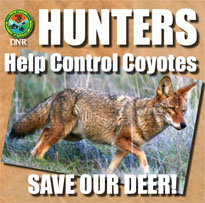Wildlife - Species

Species Specific Regulations
Coyote
Licenses: Hunting License required.Limits: Weapon restrictions according to game zones please, check Rules and Regulations for limitations.

Coyote Tracks
Coyote (Canis latrans)
Description
The coyote has the general appearance of a small shepherd-type dog; standing 23 to 26 inches at the shoulder with a slim muzzle, erect pointed ears and a bushy tail. The fur is generally a grizzled, grayish-brown but varies greatly from a light tan or reddish-tan to almost black.
Average Size
The typical coyote weighs 30 to 45 pounds, though coyotes over 60 pounds. have been recorded in other states.
Life Expectancy
Approximately 7-14 years
Preferred Habitat
Though traditionally believed to be adapted to life in open areas, coyotes have expanded into most types of habitats. While they do well in agricultural communities, their relatively high tolerance for human populations allows coyotes to exist in most areas of South Carolina. This includes mountainous regions, swamps, dense forests, as well as suburban areas.
Range
Though historically found in the western half of the United States, the coyote is now found throughout North America due to range expansion and translocation by houndsmen groups. Populations in South Carolina were established in Pickens and Oconee counties in the late 1970’s by houndsmen, and coupled with natural immigration, have since expanded to include all counties in the State.
Myth - Busted
Contrary to popular belief, the South Carolina Department of Natural Resources (SCDNR) did not stock coyotes in South Carolina to control the white-tailed deer population, or for any other reason.
Food Habits
- Coyotes are opportunistic feeders, preying upon rabbits, rodents and other small mammals, supplementing their diet with fruits, berries, and insects.
- They will eat carrion and will also prey upon deer fawns and occasionally on adult deer. One study on the Savannah River Site in Aiken County revealed that coyotes were preying upon more than half the deer fawns born.
- Coyotes can also prey on domestic poultry and livestock, particularly sheep, goats and calves. Calf predation usually subsides after weaning. Cows giving birth, especially animals having difficult births, can be susceptible to predation as they usually separate from the herd while birthing.
- On occasion, coyotes will prey on domestic pets. Pet predation is usually due to the territorial nature of the coyote and lack of an alternative prey base in suburban areas.
Reproduction
Peak Breeding Activity: Coyotes are generally monogamous, breeding mostly in February and March.
- The pups begin to leave the den at 3 to 4 weeks, are weaned at 8 to 9 weeks and the family breaks up permanently at 9 to 10 months. In areas when food is abundant, female young of the year may breed the following winter. Both adults, and on occasion other adults linked with the breeding pair, will hunt and bring food to their young.
- While raising young, coyotes will den in brushpiles, banks, gullies and old abandoned barns. Sometimes coyotes will den in burrows of other animals after enlarging and digging out their holes. Coyotes generally do not use dens except when rearing young, preferring to bed in tall grass and brush at other times of the year.
- Coyotes are capable of interbreeding with domestic dogs, but survival of the offspring is low. Typically, coy-dogs’ breeding cycles do not correspond to coyotes’ thus further breeding with coyotes is unlikely even though coy-dogs are able to reproduce.
Gestation: 63 days with average litter size of 5 to 7
Miscellaneous
Coyotes are subject to canine distemper, parvo virus, hepatitis, mange and rabies. Coyotes also harbor a variety of parasites such as fleas, ticks, worms and flukes.
Incidental take from hunting activities, most notably deer hunting, comprise most of the yearly coyote harvest in South Carolina.
Although western pelts may bring relatively high values, a strong market has not developed for the eastern coyote. Therefore, there is little incentive for sport trappers to target coyotes, keeping the commercial harvest of coyotes low. However, as nuisance coyote problems increase, the demand for contract coyote control work should increase and the number of coyotes taken from trapping by Nuisance Wildlife Control Operators (NWCOs) will rise.
Publications and Literature
Butfiloski, Jay and Buddy, Baker. 2004. Coyote - Biology and Control in South Carolina.(Adobe PDF 3MB) Columbia, South Carolina.
Simbeck, Rob. December 2008. For Wildlife Watchers: Coyote. South Carolina Wildlife Magazine, Columbia, South Carolina.
Wildlife and Freshwater Fisheries Division, Furbearer Project. 2009. Coyote Control - What a landowner CAN do in South Carolina (Adobe PDF 334KB). Columbia, South Carolina
Coyotes may be hunted throughout the year with a valid hunting license. The use of electronic calls is legal statewide, and coyotes may be hunted at night. Check the current SCDNR Hunting Rules and Regulations before hunting coyotes in your area.
Individuals may trap coyotes during the trapping season (December 1 - March 1) with a valid commercial fur harvest license along with a valid hunting license. Check the current SCDNR Trapping and Commercial Fur Harvest brochure for more information about trapping regulations.
Depredation permits are available for controlling destructive coyotes year round. No hunting or trapping license is required with a depredation permit. For more information about depredation permits, contact the DNR Furbearer Project at (803) 734-3609.
Warning: There are currently no registered toxicants for coyotes; therefore the use of any poison to attempt to control coyotes is a violation of Federal and State law. The use of poison indiscriminately kills other wildlife and pets, and may be fatal to humans that come in contact with the substance.
Jay Butfiloski - Furbearer Project Supervisor
SCDNR Furbearer Project
P. O. Box 167
Columbia, SC 29202-0167
Phone: 803-734-3886
Fax: 803-734-6020
E-mail: ButfiloskiJ@dnr.sc.gov

